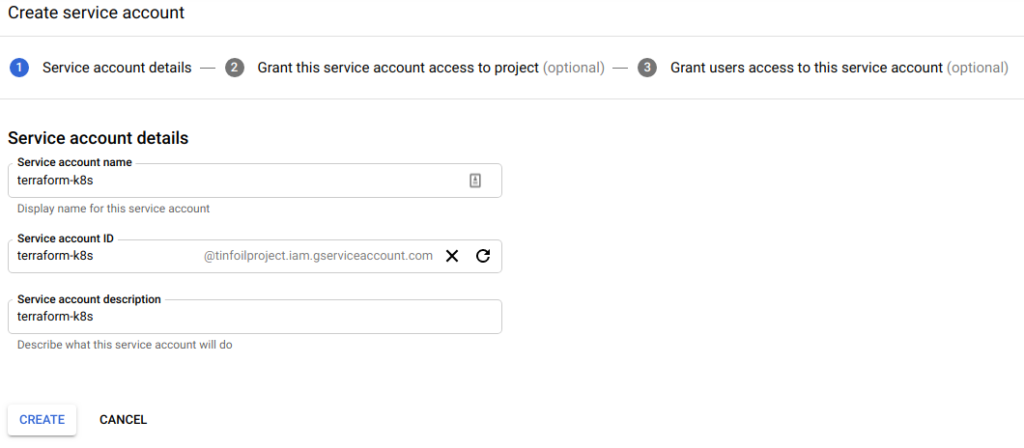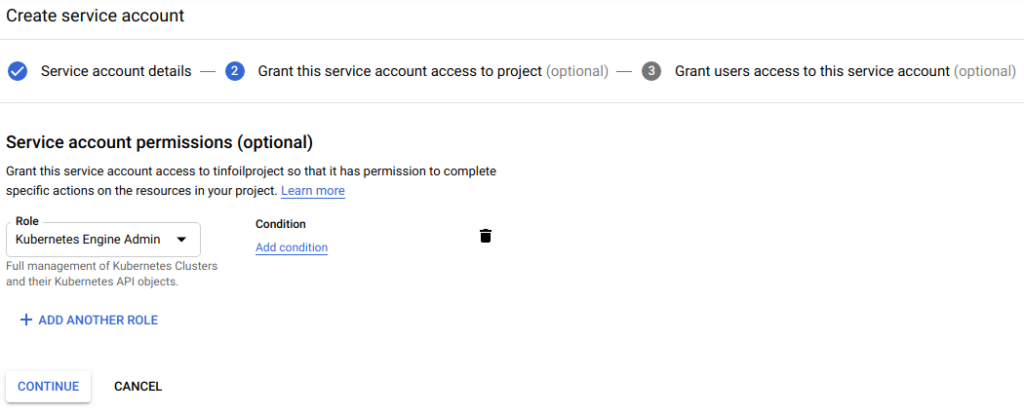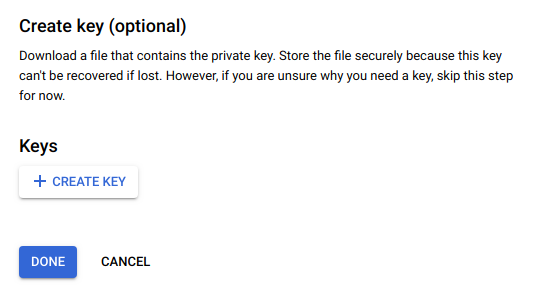Creating Kubernetes Clusters in GCP With Terraform
Google Cloud Platform tends to be forgotten from the conversation a lot when talking about public cloud offerings, however their hosted Kubernetes offering GKE (Google Kubernetes Engine) has for me been the best of the major offerings for getting to grips with the platform and the best reason to use GCP at all. Without much issue we can get Terraform integrated with GCP, provision and scale out clusters as we need.

GCP Authentication - IAM Service Accounts
Before going any further, we’re working with a GCP project named tinfoilproject, that’s where we’re going to make our cluster.
GCP has a particularly nice IAM setup and a dedicated section for Service Accounts to help to segregate programmatic access from real users. We’ll need to start here to get access to GCP for external systems. We can access this in the GCP Console from IAM & Admin > Service Accounts:

From here we can create a new Service Account. At Step 1 we name the account, we’re calling the Service Account terraform-k8s:

Click Create and at Step 2, define which access the Service Account needs, we’re going to grant full access to GKE:

Finally, at Step 3 click Create Key and select JSON for a key format, a JSON formatted key file will be downloaded. Be aware that this contains a Private Key and can be used to gain access to your GCP environment and should be handled as a secret. In our examples we have saved the file as terraformk8s.json.

Terraform - Integrating the GCP Provider
Now that we have a means of authenticating, we can configure a provider in Terraform. In this example we will be using the terraformk8s.json file stored locally, this would not be advisable in most production scenarios unless permissions are incredibly secure (it appears that the secrets can be centrally managed either by using Vault or GCP’s own Secrets Engine, but that’s for another post).
Below is our configured provider.tf which will allow us to execute terraform init without issue:
#--provider.tf
provider "google" {
credentials = file("terraformk8s.json")
project = "tinfoilproject"
region = "europe-west2"
}
Terraform - Cluster Parameters
Before we deploy anything, we’ll need to know some basic parameters:
- 3 Clusters, named tinfoilcluster01-03.
- Each cluster will have a /16 subnet, numbered from 10.1.0.0-10.3.0.0
- Each Cluster will have a 3 node pool (named tinfoilnodepool01-03, using machine type of n1-standard-1 (1vCPU and 3.75gb RAM), this is pretty high and should be able to take a massive workload.
To allow for future growth or shrinking, we’ll define all of this data in variables.tf so we can use Terraform’s count function for iterations. This allows us a great degree of flexibility for future scaling, especially when we need to start considering CI/CD pipelines:
#--variables.tf
variable "location" {
type = string
description = "Primary Location"
default = "europe-west2-a"
}
variable "cluster_names" {
description = "All GKE Clusters"
type = list(string)
default = [
"tinfoilcluster01",
"tinfoilcluster02",
"tinfoilcluster03",
]
}
variable "cluster_cidr_blocks" {
description = "All GKE Clusters"
type = list(string)
default = [
"10.0.0.0/16",
"10.1.0.0/16",
"10.2.0.0/16",
]
}
variable "node_pool_names" {
description = "All GKE Node Pools"
type = list(string)
default = [
"tinfoilnodepool01",
"tinfoilnodepool02",
"tinfoilnodepool03",
]
}
Terraform - Immutable Cluster Deployment
Now that we know what we want to deploy, we can get the cluster deployed, below is our main.tf:
#--main.tf
resource "google_container_cluster" "cluster" {
name = var.cluster_names[count.index]
location = var.location
remove_default_node_pool = true
initial_node_count = 1
cluster_ipv4_cidr = var.cluster_cidr_blocks[count.index]
count = length(var.cluster_names)
master_auth {
username = ""
password = ""
client_certificate_config {
issue_client_certificate = true
}
}
}
resource "google_container_node_pool" "nodes" {
name = var.node_pool_names[count.index]
count = length(var.cluster_names)
location = var.location
cluster = google_container_cluster.cluster[count.index].name
node_count = 3
node_config {
preemptible = true
machine_type = "n1-standard-1"
metadata = {
disable-legacy-endpoints = "true"
}
oauth_scopes = [
"https://www.googleapis.com/auth/logging.write",
"https://www.googleapis.com/auth/monitoring",
]
}
}
With all this in place, we can now run terraform init, however we can expect something of a delay as the provision of clusters isn’t a swift process, however eventually we will see our clusters created:

If we drill in to one of the clusters, we can see that default version of Kubernetes has deployed and that the node pools have built:


From here we can begin to deploy workloads to create containerised services we can also deploy load balancers and control ingress/egress, however this is all a bit manual so next projects are going to be looking in to other integrations, probably Helm.